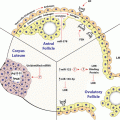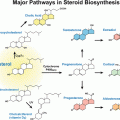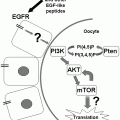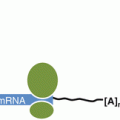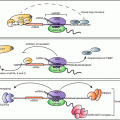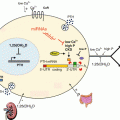Fig. 10.1
mTORC1 couples leptin secretion to the adipocyte size. Insulin and nutrients activate leptin biosynthesis via the mTORC1-mediated pathway that also promotes storage of triglycerides and increases the size of the cell. De novo synthesized leptin molecules are partitioned between constitutive and regulated secretion and immediate degradation
References
Appel B, Fried SK (1992) Effects of insulin and dexamethasone on lipoprotein lipase in human adipose tissue. Am J Physiol 262:E695–E699PubMed
Bentzinger CF, Romanino K, Cloetta D, Lin S, Mascarenhas JB, Oliveri F, Xia J, Casanova E, Costa CF, Brink M, Zorzato F, Hall MN, Ruegg MA (2008) Skeletal muscle-specific ablation of raptor, but not of rictor, causes metabolic changes and results in muscle dystrophy. Cell Metab 8:411–424PubMedCrossRef
Bogan JS, Lodish HF (1999) Two compartments for insulin-stimulated exocytosis in 3T3-L1 adipocytes defined by endogenous ACRP30 and GLUT4. J Cell Biol 146:609–620PubMedPubMedCentralCrossRef
Bornstein SR, Abu-Asab M, Glasow A, Path G, Hauner H, Tsokos M, Chrousos GP, Scherbaum WA (2000) Immunohistochemical and ultrastructural localization of leptin and leptin receptor in human white adipose tissue and differentiating human adipose cells in primary culture. Diabetes 49:532–538PubMedCrossRef
Carnevalli LS, Masuda K, Frigerio F, Le Bacquer O, Um SH, Gandin V, Topisirovic I, Sonenberg N, Thomas G, Kozma SC (2010) S6K1 plays a critical role in early adipocyte differentiation. Dev Cell 18:763–774PubMedPubMedCentralCrossRef
Chakrabarti P, Anno T, Manning BD, Luo Z, Kandror KV (2008) The mammalian target of rapamycin complex 1 regulates leptin biosynthesis in adipocytes at the level of translation: the role of the 5′-untranslated region in the expression of leptin messenger ribonucleic acid. Mol Endocrinol 22:2260–2267PubMedPubMedCentralCrossRef
Chakrabarti P, English T, Shi J, Smas CM, Kandror KV (2010) The mTOR complex 1 suppresses lipolysis, stimulates lipogenesis and promotes fat storage. Diabetes 59:775–781PubMedPubMedCentralCrossRef
Chakrabarti P, Kim JY, Singh M, Shin YK, Kim J, Kumbrink J, Wu Y, Lee MJ, Kirsch KH, Fried SK, Kandror KV (2013) Insulin inhibits lipolysis in adipocytes via the evolutionary conserved mTORC1-Egr1-ATGL-mediated pathway. Mol Cell Biol 33:3659–3666PubMedPubMedCentralCrossRef
Dibble CC, Manning BD (2013) Signal integration by mTORC1 coordinates nutrient input with biosynthetic output. Nat Cell Biol 15:555–564PubMedPubMedCentralCrossRef
Efeyan A, Zoncu R, Sabatini DM (2012) Amino acids and mTORC1: from lysosomes to disease. Trends Mol Med 18:524–533PubMedPubMedCentralCrossRef
Foster KG, Fingar DC (2010) Mammalian target of rapamycin (mTOR): conducting the cellular signaling symphony. J Biol Chem 285:14071–14077PubMedPubMedCentralCrossRef
Frederich RC, Lollmann B, Hamann A, Napolitano-Rosen A, Kahn BB, Lowell BB, Flier JS (1995) Expression of ob mRNA and its encoded protein in rodents. Impact of nutrition and obesity. J Clin Invest 96:1658–1663PubMedPubMedCentralCrossRef
Friedman JM (2009) Leptin at 14 y of age: an ongoing story. Am J Clin Nutr 89:973S–979SPubMedPubMedCentralCrossRef
Howell JJ, Manning BD (2011) mTOR couples cellular nutrient sensing to organismal metabolic homeostasis. Trends Endocrinol Metab 22:94–102PubMedPubMedCentralCrossRef
Stay updated, free articles. Join our Telegram channel

Full access? Get Clinical Tree


